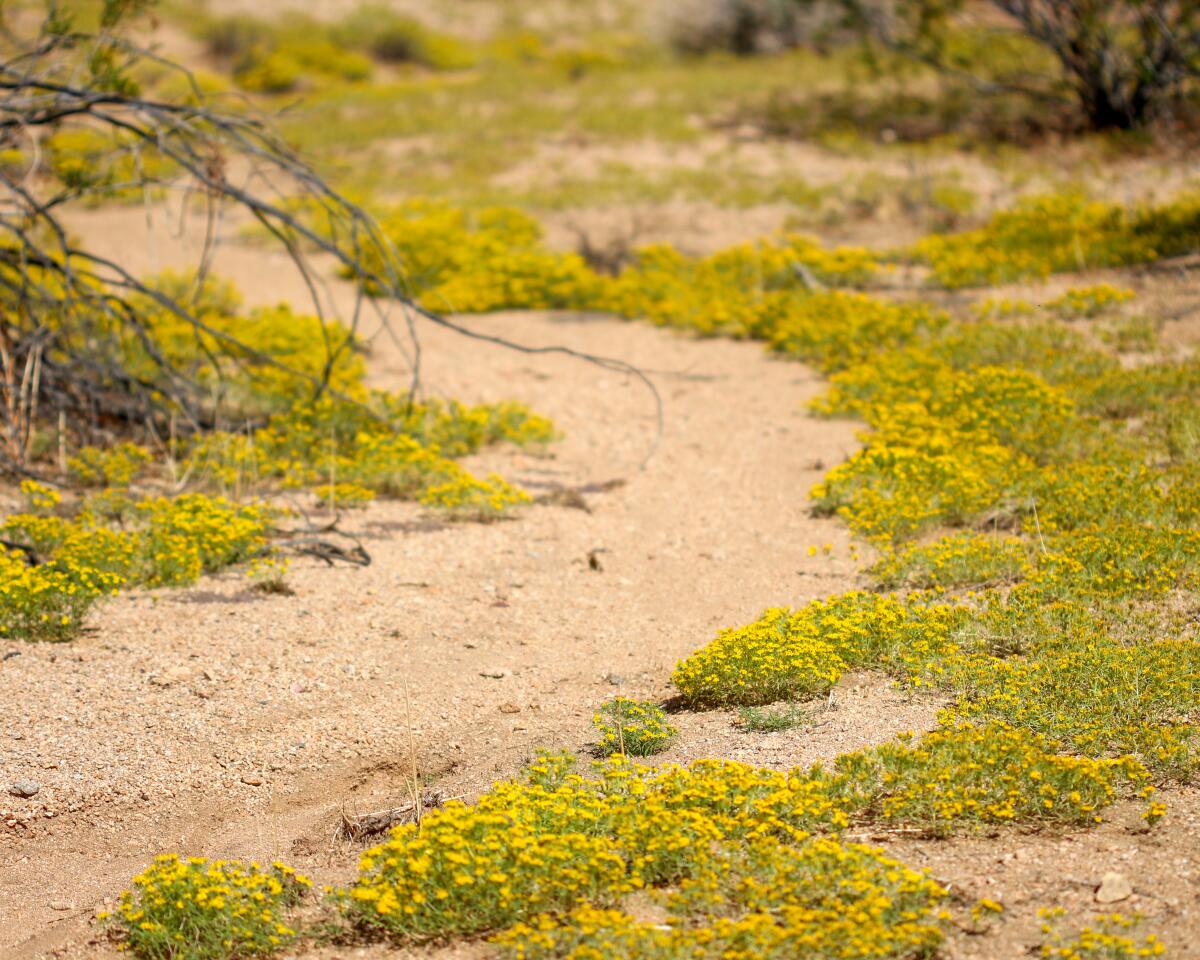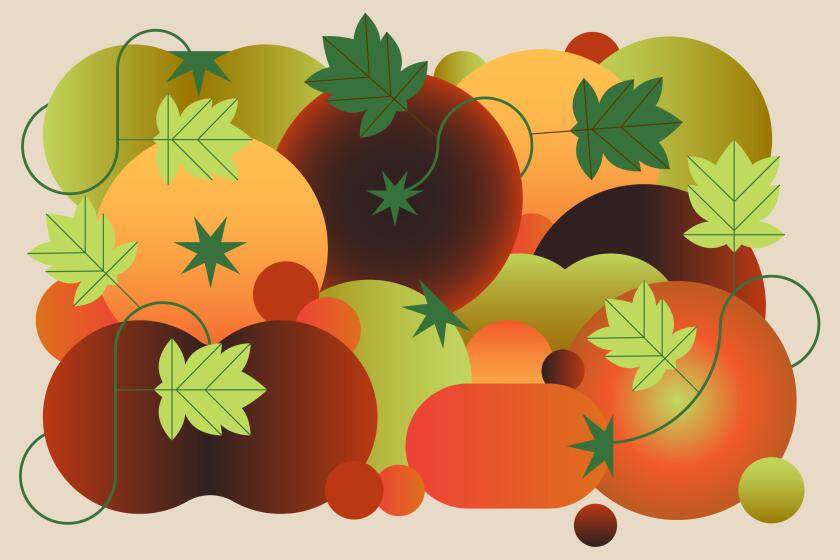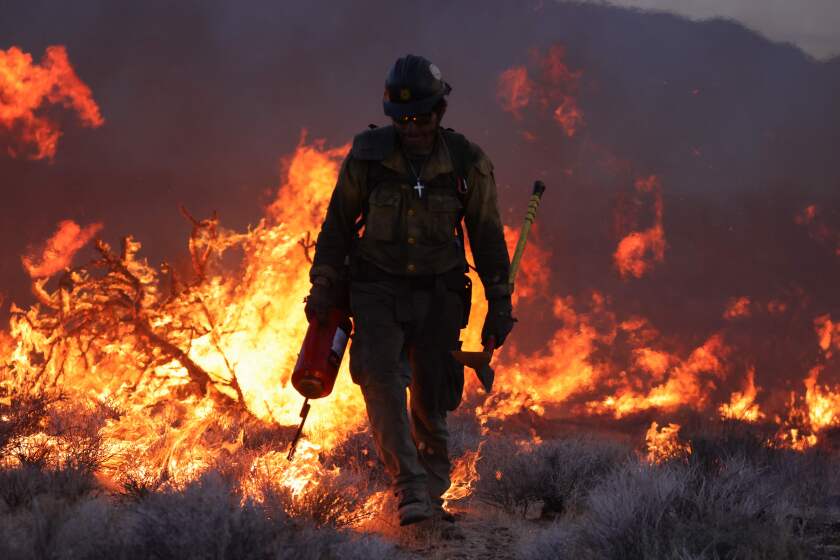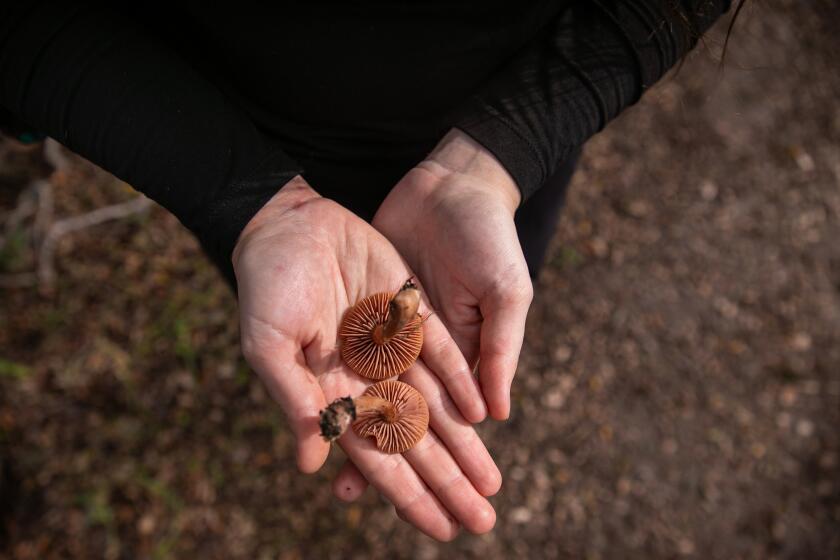Will Tropical Storm Hilary’s record-smashing rain lead to a wildflower bloom?

- Share via
Tropical Storm Hilary’s historic rains are great news for wildflower lovers — if you’re into shy desert blooms like the arcing spikes of fringed amaranth (Amaranthus fimbriatus), pops of purple from trailing windmills (Allionia incarnata) or golden, odiferous clumps of cinchweed (Pectis papposa).
But don’t expect the summer downpour to create another lush superbloom of poppies and lupines this fall. “Those plants we enjoy in the spring are called winter annuals because they need cold conditions to germinate,” said botanist Naomi Fraga, director of conservation for the California Botanic Garden. “They need wet and cold conditions to bloom.”

Certain parts of the desert, however, are full of opportunistic seeds that evolved to burst into bloom after any good summer rain. “There should be some amazing sights to behold in the desert this fall,” said Evan Meyer, executive director of the Theodore Payne Foundation. “I suggest that people look at the rainfall figures to see what [desert] areas had the highest rainfall, and then go check them out, because it’s going to be a very special, transformational moment.”
Should we pick our homegrown tomatoes when they’re green? Three experts weigh in with harvesting tips, plus plant-related activities for September 2023.
Still, Meyer said, this fall bloom won’t be like what we see in the spring along the more coastal foothills of Southern California. “There won’t be millions of wildflowers, the kind enjoyed by the average flower chaser in California. It will take more homework to find the really great stuff [in the desert], but that just makes it more fun.”
Fraga specializes in searching for small, easy-to-miss flowers of the desert, and her excitement was evident when she posted a long thread on X (formerly Twitter) highlighting the flowers she hopes to see in the East Mojave and Sonoran deserts, where plants have evolved to respond to summer monsoonal rains (which leaves out areas like Death Valley).

“The summer monsoon brings up a whole different suite of wildflowers then we see in the spring,” she wrote. “There are not as many species, but they are still stunners!”
Fraga said she’s particularly excited to see the fringed amaranths bloom. “It produces really beautiful fringed fruits .... they’re not particularly palatable [to humans] but their seeds are important to our restoration work.”

Warm-season grasses like blue grama (Bouteloua gracilis) with their fuzzy caterpillar-looking seed stalks, should start greening up those desert areas by early October, Fraga said, and perennial shrubs like the purple Schott indigobush (Psorothamnus schottii) and butter-colored spiny senna (Senna armata) could see a second bloom. But Fraga is particularly fond of the smaller, easier-to-miss flowers, like the dusty green rattlesnake sandmat (Euphorbia albomarginata) that, like its namesake, creeps close to the ground with white, tiny saucer-shaped flowers.
Desert wildflower seekers should plan on an overnight outing, said Meyer, since the blooms will probably be a few hours away, and explorers should do some research to make sure they’ll be driving on passable roads.
From sequoias to bristlecone pines, millions of California trees are succumbing to worsening wildfires, severe drought, extreme heat and disease.
The heavy summer rain could also be a boom for SoCal mushroom hunters this fall, said Lucinda McDade, executive director of the California Botanic Garden. “The fungi are going to respond to all this rain, and if I were a serious mushroom person, I would look in the mountains a little bit,” she said, “but I think we’re going to also have some wonderful mushroom blooms in our lawns or around our trees. We’re going to see a massive amount of mushrooms this fall.”

Closer to L.A., the rare summer storm certainly refreshed our plants by washing off all the dust, and it could encourage longer blooms on salvias and other perennials, but Fraga said the rain could also fuel the growth of undesirable invasive plants, like tumbleweeds.
The best tips and tricks for identifying and responsibly gathering fungi in the wild.
“They’re a very bad one that responds well to summer rain,” Fraga said. “They’re late bloomers so I can see a profusion of those, and maybe a repeat of the detrimental episodes we saw in 2018 in Victorville, when huge tumbleweeds rolled down the streets and people got trapped in their homes. They really caused some chaos.”
So if you go out wildflower hunting this fall, drive a vehicle with good clearance, Meyer advised. Be respectful of desert terrain and keep your eyes open for patches of spare beauty.

More to Read
Sign up for The Wild
We’ll help you find the best places to hike, bike and run, as well as the perfect silent spots for meditation and yoga.
You may occasionally receive promotional content from the Los Angeles Times.














